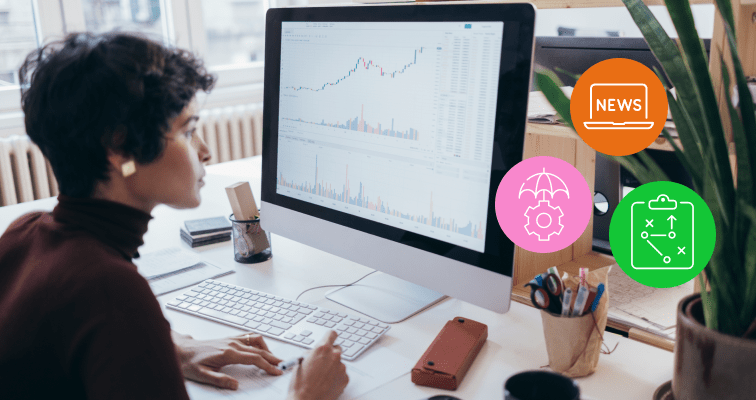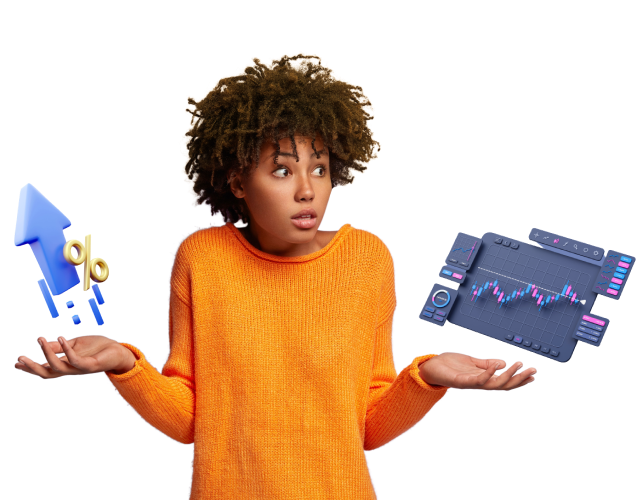The terms “investing” and “trading” are often used interchangeably but there are distinct differences between the two. In this article we explain what investing and trading are individually and assess the key differences between the two methods of gaining exposure to the financial markets.
Investing and trading are both ways of gaining exposure to the financial markets by buying instruments such as stocks, ETFs, commodities, indices or cryptoassets. The assets themselves are not the factor that distinguishes investing from trading. Instead, the main difference is found in the length of time assets are held.
There are a number of other ways in which they are similar, but there are also fundamental differences between the approaches. Understanding the nuances of both techniques is an important part of ensuring you approach the markets in a way that suits you. This article defines investing and trading and focuses on the similarities and differences between the two approaches.
What Is Investing?
Investing vs Trading: A Comprehensive Guide to Making Informed Decisions
Investing involves buying assets with the aim of making a long-term financial return.
Investing can involve building a portfolio that contains a range of assets and managing it over numerous years.

The length of the investment process will depend on your individual circumstances. Some people invest to achieve long-term financial independence and retire early, whereas others invest to fund medium-term goals such as career breaks or weddings. Regardless of the aim, investing usually involves following a strategy with an investment time horizon of at least one year.
Investors will usually choose assets that they expect to increase in value by the time they are ready to convert their investment back into cash. There are no definitive rules about which assets should go into an investment portfolio, and diversifying your portfolio across different asset classes is an option that many experienced investors choose to take.
Tip: ‘Active’ investors try to beat the market, whereas ‘passive’ investors aim to track the overall returns of a market.
What Is Trading?
Trading involves buying and selling securities within small time frames, usually ranging from seconds to weeks. Trading is more speculative than investing and involves the implementation of short-term strategies.

Traders tend to focus on which direction an asset’s price is likely to move, rather than the reason behind it. These moves might be driven by shock news events or other momentary pricing anomalies, which can be explained by technical analysis.
Trading requires active management of positions and the monitoring of news feeds. Traders are also likely to use risk management techniques, such as stop-loss orders, to automatically close out losing trades, rather than waiting for them to become profitable again.
Tip: Trading demands a lot more time and resources than investing and higher trading volumes equate to higher administrative costs and trading fees.

What Are the Key Differences Between Investing and Trading?
The major difference between investing and trading is the length of time for which a position might typically be held. Investing can involve strategies with much longer time horizons, whereas traders aim to make profits from short-term price moves.
In addition, traders and investors set up, and engage with the markets, in different ways. The research required is different for both approaches, as are the risk management tools utilised.
| Investing | Trading | |
|---|---|---|
| Holding Period | Long | Short |
| Trading Frequency | Low | High |
| Portfolio Diversification | Yes | No |
| Time Required to Manage | Low | High |
| Importance of Fundamental Analysis | High | Low |
| Importance of Technical Analysis | Low | High |
| Stop-Losses | Unlikely | Likely |
| Funding Styles | Regular subscriptions | One-off deposits |
| Use of Leverage | No | Yes |
| Short Selling | No | Yes |
| CFDs | No | Yes |
| Buy-and-Hold | Yes | No |
| Market conditions | All | High volatility |
Final Thoughts
Trading and investing have many similarities, and explaining the differences can be done by considering the commonly used phrase: trading involves “timing the market,” whereas investing is all about “time in the market.”
Find out more ways to trade and invest by heading to the eToro Academy.
Quiz
FAQ
- What is the difference between investing and saving?
-
Investing involves putting some of your capital into assets traded in the financial markets. When you start investing, the value of these assets may or may not increase in value. On the other hand, saving offers more certainty regarding returns. For example, putting money into a bank savings account with a fixed rate of interest will guarantee a pre-agreed percentage increase, but with no possibility of outperforming this interest rate.
- Are there different styles of investing?
-
Investing styles are primarily split into two different approaches: “active” and “passive.” The former tries to generate returns that beat the broader market. The latter aims to track the general price movements of a benchmark index, such as the FTSE 100 or S&P 500.
- How does tax work on investments?
-
Your personal circumstances will determine how much tax you pay on any investment returns. It’s important to consider the tax codes that apply to you and whether you’re able to take advantage of any tax efficiency schemes, such as ISAs, which are offered by governments to incentivise investing.
This information is for educational purposes only and should not be taken as investment advice, personal recommendation, or an offer of, or solicitation to, buy or sell any financial instruments.
This material has been prepared without regard to any particular investment objectives or financial situation and has not been prepared in accordance with the legal and regulatory requirements to promote independent research. Not all of the financial instruments and services referred to are offered by eToro and any references to past performance of a financial instrument, index, or a packaged investment product are not, and should not be taken as, a reliable indicator of future results.
eToro makes no representation and assumes no liability as to the accuracy or completeness of the content of this guide. Make sure you understand the risks involved in trading before committing any capital. Never risk more than you are prepared to lose.


